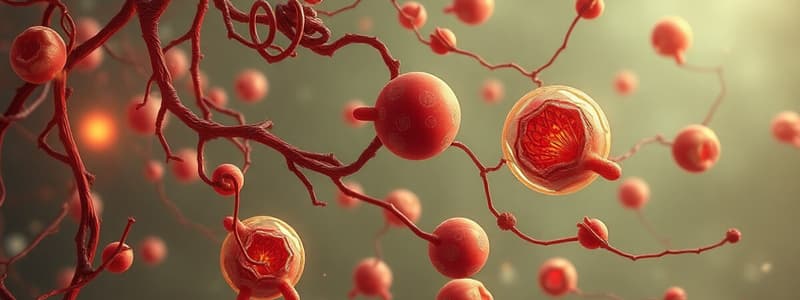Podcast
Questions and Answers
Which hormone is produced by the ovaries and has an inhibitory effect on erythropoiesis?
Which hormone is produced by the ovaries and has an inhibitory effect on erythropoiesis?
- Prolactin
- Testosterone
- Estrogen (correct)
- Growth Hormone
What is the primary function of erythropoietin (EPO)?
What is the primary function of erythropoietin (EPO)?
- To promote tissue repair
- To stimulate the production of red blood cells (correct)
- To increase platelet counts
- To inhibit white blood cell production
How long does it take for CFU-E to transition to Rubriblast?
How long does it take for CFU-E to transition to Rubriblast?
- 3 days
- 5 days
- 10 days
- 1 week (correct)
What is the earliest committed progenitor cell in red blood cell development?
What is the earliest committed progenitor cell in red blood cell development?
Which hormone is primarily responsible for stimulating erythropoiesis among testosterone, growth hormone, and prolactin?
Which hormone is primarily responsible for stimulating erythropoiesis among testosterone, growth hormone, and prolactin?
During erythropoiesis, which stage is immediately after CFU-E?
During erythropoiesis, which stage is immediately after CFU-E?
Which of the following stages is not a precursor in the maturation of red blood cells?
Which of the following stages is not a precursor in the maturation of red blood cells?
Flashcards
Growth Hormone
Growth Hormone
A hormone that stimulates EPOiesis (red blood cell production) produced by the anterior pituitary gland.
Testosterone
Testosterone
A hormone that stimulates EPOiesis produced by Leydig cells in the testes.
Prolactin
Prolactin
A hormone that stimulates EPOiesis produced by the pituitary gland.
Estrogen
Estrogen
Signup and view all the flashcards
BFU-E
BFU-E
Signup and view all the flashcards
CFU-E
CFU-E
Signup and view all the flashcards
BFU-E to CFU-E transition time
BFU-E to CFU-E transition time
Signup and view all the flashcards
BFU-E to mature erythrocyte timeline
BFU-E to mature erythrocyte timeline
Signup and view all the flashcards
Rubriblastic stage
Rubriblastic stage
Signup and view all the flashcards
Normoblastic stage
Normoblastic stage
Signup and view all the flashcards
Erythroblastic stage
Erythroblastic stage
Signup and view all the flashcards
Reticulocyte
Reticulocyte
Signup and view all the flashcards
Mature erythrocyte
Mature erythrocyte
Signup and view all the flashcards
Study Notes
Hormone Production and Stimulation
- Growth hormone is produced by the anterior pituitary gland and stimulates EPOiesis.
- Testosterone is produced by Leydig cells in the testes and stimulates EPOiesis.
- Prolactin is produced by the pituitary gland and stimulates EPOiesis.
- Estrogen is produced by the ovaries and inhibits EPOiesis.
RBC Maturation Stages
- BFU-E (Burst Forming Unit Erythroid) is the earliest committed progenitor.
- CFU-E (Colony Forming Unit Erythroid) is a later stage.
- Progression from BFU-E to CFU-E takes one week (7 days).
- Progression from CFU-E to Rubriblast takes one week.
- Altogether, it takes approximately 18 to 21 days for a BFU-E to mature into an erythrocyte. Six days of this time is spent as easily-recognized precursors in the bone marrow.
Stages of Erythropoiesis
-
Rubriblastic Stage:
- Rubriblast
- Prorubricyte
- Rubricyte
- Metarubricyte
-
Normoblastic Stage:
- Pronormoblast
- Basophilic Normoblast or Early Normoblast
- Polychromatophilic Normoblast or Intermediate Normoblast
- Orthochromatic Normoblast or Late Normoblast
-
Erythroblastic Stage:
- Proerythroblast
- Basophilic Erythroblast or Early Erythroblast
- Polychromatophilic Erythroblast or Intermediate Erythroblast
- Orthochromatic Erythroblast or Late Erythroblast
-
Reticulocyte Stage:
- Reticulocyte (same color cytoplasm as mature RBC)
-
Mature Erythrocyte:
- Mature erythrocyte (final stage)
Studying That Suits You
Use AI to generate personalized quizzes and flashcards to suit your learning preferences.




